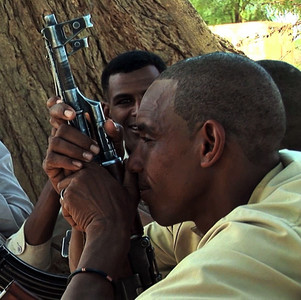Why South Sudanese “need” firearms
Decades of civil war left in their wake gigantic challenges for both Sudan and South Sudan. The most daunting of these was the militarisation of many communities, the ubiquity of firearms and widespread communal violence fanned by easy access to light weapons and small arms.
Nothing speaks more loudly about the impact of the north-south war on South Sudanese communities than the number of guns it left in the hands of civilians and their use in communal feuds, crime and revenge.
It is not about the guns, but rather why people feel they need weapons in the first place.”Weapons alone do not kill, however. They only kill because human beings use them. It is therefore important to think about what is driving this violence, and why people feel the need to acquire guns.
Social shifts are underway, forcing many people to reach for firearms. The starting point for this shift was the Sudanese government’s use of a counterinsurgency tactic of recruiting, training and arming young South Sudanese and deploying them to fight against the Sudan People’s Liberation Army (SPLA) and against their own people, a kind of war by proxy. This tactic had an immediate consequence: It seriously damaged ethnic relations and, in turn, these wrecked relations were more likely to be settled by using guns.
The traditional ethos was utterly abandoned under the weight of the anonymous firearm killings, as opposed to killings that once involved face-to-face confrontation and spears.
The next step in the development of this gun-focused subculture was the SPLA’s encouragement of civilians to acquire weapons to protect themselves against Sudan’s government-sponsored militias, especially against the Popular Defense Force (PDF) made up of the Baggara from Darfur and Kordofan. This wreaked havoc in northern parts of Bahr el Ghazal and Upper Nile regions.
The third step was the growing trend of cattle rustling, which became rampant in seven out of the ten states of the country. Many young men acquired arms to protect their livestock and retrieve
their stolen cattle.
The fourth driver were various splits within the SPLA, beginning in 1991 when Riek Machar broke away and tried to form his own wing of the organisation. This quickly took on an ethnic colour, with Machar, a Nuer being supported by other Nuer, which sparked the notorious Bor massacre.
Meanwhile, the leader of the SPLA, the late John Garang, was mainly supported by his Dinka ethnic group. Throughout the 1990s the SPLA continued to clash with militias. Some of the weapons, sourced from supportive countries by the SPLA, found their way into the hands of the civilians. This had deadly consequences: The guns ushered in a new level of viciousness and destruction in comparison to when these ethnic groups used to fight with clubs and spears.
The last step in the development of this new gun culture was the 2005 Comprehensive Peace Agreement (CPA) itself. Armed groups were encouraged to join the SPLA, the new national defense force, and many of them sold their weapons for cash or cows. These were keenly acquired by the would-be cattle rustlers among the civilians.
If there are no guarantees of security and justice, and if citizens suspect that the state has a total monopoly of the legitimate use of force, then the South Sudanese will continue to find ways of getting hold of guns.”When South Sudan became independent in 2011, people urgently wanted security, especially communities living in regions worst affected by the war. So it was only natural that the government unveiled massive civilian disarmament campaigns. Ethnic divides hampered these, in particular deep seated fears that other groups might be better armed.
This suspicion meant most people either ignored the disarmament efforts or, worse still, acquired more weapons.
Civilian disarmament has been generally rated as a failure or a limited success. Problems included the heavy-handed approach, which deterred people from coming forward with their guns.
Meanwhile, they made the mistake of not simultaneously disarming competing groups. But the biggest problem was the assumption that removal of guns alone would solve South Sudan’s security problems. This ignores one obvious fact: It is not about the guns, but rather why people feel they need weapons in the first place. If these drivers of violence are not tackled, if there are no guarantees of security and justice, and if citizens suspect that the state has a total monopoly of the legitimate use of force, then the South Sudanese will continue to find ways of getting hold of guns.
Far from being a subculture, the continued use of firearms and their spread among civilians are rooted in the lack of justice and state protection, suspicion, ethnic feuds and how easy guns are to acquire.


